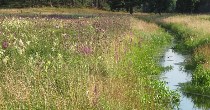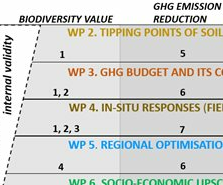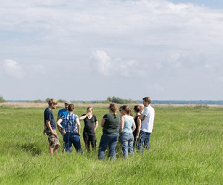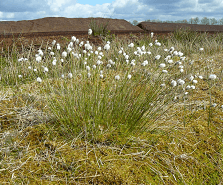CLEARANCE
CircuLar Economy Approach to River pollution by Agricultural Nutrients with use of Carbon-storing Ecosystems
WBZ (Wetland buffer zones) are wetlands located between agricultural land and aquatic ecosystems, capturing nutrient-rich runoff water before it reaches rivers and lakes to reduce nutrient loads in surface waters at the water-land interface.
Scope of the CLEARANCE: rivers and riverine wetlands
River ecosystems, along with riparian landscapes, are essential for maintaining and regulating natural cycles of water and nutrient flows between terrestrial and aquatic ecosystems. Riverine wetlands play a key role, and are hubs of biodiversity and ecosystem services. Yet, due to the large-scale modification of European rivers and wetlands, and the intensification of agricultural productions, these functions are often seriously impaired. The CLEARANCE project seeks to implement wetland solutions for clean water provision and restoration of vanishing riverine nature.
Goals of the CLEARANCE
The primary goals of CLEARANCE are to:
- enhance nutrient capture from surface water, and purify water on its pathway from agricultural fields into rivers, lakes, and finally to the sea by the use of wetland buffer zones (WBZ), and
- explore synergies and constraints of this approach with other ecosystem services of riparian wetlands such as flood protection, carbon sequestration, biomass production and recreation.

CLEARANCE guidelines (English)
A brochure about the problems arising at the interface between the land and water – generated in combination by the intensive development of large-scale agriculture, climate change caused by the burning of fossil fuels, and the drastic transformation of the rural landscape.
Wnioski z projektu CLEARANCE (Polish)
Niniejsza broszura opisuje problemy powstałe na styku lądu i wody – problemy spowodowane łącznie przez intensywny rozwój wielkoskalowego rolnictwa, zmiany klimatu wywołane spalaniem paliw kopalnych oraz drastyczne przekształcenie krajobrazu
The project stems from several different but synergistic concepts, developed in relation to river and wetland ecosystems:
- Restoration of wetland buffer zones (WBZ) as a remedy to nutrient pollution by agriculture has been developing rapidly in several countries over the last decades. The theory behind CLEARANCE is largely based upon experiences in Denmark, where for more than two decades, restoration of WBZs has been accepted as an effective policy mechanism to counter diffuse nutrient pollution.
- Restoration of rivers and riverine landscapes for flood protection and mitigation of droughts’ effects. Re-meandering, floodplain re-connection to the channel and re-establishment of back-swamp habitats are elements of river restoration programmes that target the reduction of flood and drought risk.
- Wet agriculture, i.e. productive use of wetlands. Harvesting vegetation allows for additional removal of nutrients, while at the same time maintaining the agricultural function of riparian areas. This concept includes “paludiculture”, i.e. biomass production and utilisation in wet and rewetted peatlands. Paludiculture has been developed primarily as a mean to reduce greenhouse gas emissions from drained peatlands, which contribute approximately 5% to the global anthropogenic GHG emissions (Joosten at all, 2012). Importantly, we highlight the substantial synergies that exist between the functions of nutrient capture and plant biomass utilisation.
- Conservation and restoration of riparian biodiversity. This is primarily enhanced by improving the naturalness of the river and its proximity. Riparian habitats are the most species-rich environments, largely due to interactions between aquatic and terrestrial environment and presence of dynamic hydromorphic processes. They are also migration corridors for wildlife (Roe and Gorges, 2007).
All above functions of riparian areas are analysed using the ecosystem services approach, which allows quantification and comparison of different systems including use and non-use values. Additionally, the circular economy context provides bases for evaluating benefits of the synergistic functions of wetland buffer zones in terms of economic gains and reduction of pollutants. Finally, environmental ethics, social network analysis and policy reviews are also used to complement the studies from the societal perspective.
CLEARANCE consortium seeks to implement wetland solutions that address growing societal demands for clean water provision and the necessity to preserve and restore vanishing riverine nature – as a sustainable alternative to technical ways of managing and transforming rivers by hard-infrastructure projects at the costs of their biodiversity and ecosystem services.
Clearance Stakeholder-Workshop in Warsaw, Poland
Date: 15th March 2019
Location: University of Warsaw Biological and Chemical Research Centre, Aula B ul. Żwirki I Wigury 101, 02-089 Warszawa
Documents: Program English | Program Polish | Additional workshop information in Polish
Clearance Brussels-Workshop in Brussels, Belgium
Date: 12th September 2018
Location: Meeting room of the federal state Western-Pomerania at EU, Boulevard Saint Michel 80, 1040 Brussels
Participants: EU-policy-makers, member state and civil society, NGOs, scientists and companies
Documents: Program
Declaration: during the workshop policy recommendations for the European Water Framework Directive were prepaired.
Clearance Stakeholder-Workshop and excursion in Aarhus, Denmark
Date: 14th/15th September 2018
Location: University of Aarhus
Documents: Program | Presentations | Report
Clearance Stakeholder-Workshop in Greifswald, Germany
Date: 28th November 2018
Location: Town hall of Greifswald
Documents: Program | Presentations | Report
Local media response (in German):
Eckhard Oberdörfer, Greifswald soll Leuchturm der Paludikultur werden Ostsee-Zeitung, 5.12.2018, more...
We would like to thank the EU and the Innovation Fund Denmark (Denmark), the Federal Ministry of Food and Agriculture (Germany) , the National Centre for Research and Development (Poland) for funding, in the frame of the collaborative international consortium CLEARANCE financed under the ERA-NET Cofund WaterWorks2015 Call. This ERA-NET is an integral part of the 2016 Joint Activities developed by the Water Challenges for a Changing World Joint Programme Initiative (Water JPI).
Details
References
- Joosten, H., Tapio-Biström, M.L., Tol, S., 2012. Peatlands - guidance for climate change mitigation through conservation, rehabilitation and sustainable use (second edition). FAO & Wetlands International Landscape.
- Roe, J.H., Georges, A., 2007. Heterogeneous wetland complexes, buffer zones, and travel corridors: Landscape management for freshwater reptiles. Biological Conservation 135, 67-76.











